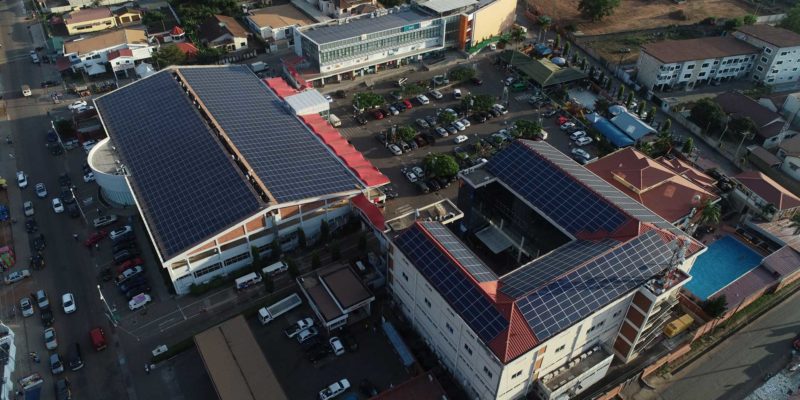Why this project?
Solar projects in North America, Europe and most parts of Asia, are about climate change and protecting the environment. But in Africa, and especially Ghana, it is first about the cost of electricity.
A&C Development Company took the decision to transform their entire retail facility into a solar farm, firstly to help tenants reduce their cost of doing business, and secondly to help protect the environment from catastrophic climate change.
With more than 50% of Ghana’s power coming from thermal plants, the pollutants and fumes coming from such plants are clouding the skies and negatively impacting the environment.
The main contractor on the project is SunPower Innovations, a 100% Ghanaian-owned, leading solar engineering, procurement and construction company that provides reliable and affordable off-grid, on-grid and hybrid solar systems for homes, businesses and government agencies. SunPower has contracted the structural engineering to another local company, AWD.
Cost of the project
The initial investment into the project stands at $3 million (US). Out of that, cables, panels and other hardware account for $1.5 million, while the battery system, which stores the energy for nighttime and cloudy days, cost another $1.5 million.
Extensive engagements with architects and structural engineers, including very experienced external electrical engineers and consultants, are ongoing.
At the end of the installation, the solar system will be integrated with the current electrical system at the retail and business center.
Positioning of panels
The A&C Mall covers a total of five acres of land. SunPower is installing panels on all the roofing space, the children’s play area and portions of the car park. The roof alone is providing half of the power, while the car park and the children’s playground comprise the other half.
Man hours and HSEQ
For this project, nothing less than six months of work is required. The first four months include constructions, installations and positioning of panels. The last two involves battery installations and testing. The first four months will see 12-hour workdays and the last two will involve 24-hour workdays.
For the first four months, at 12 hours per day, that offers 60 hours a week, which totals 240 hours a month. This means a spending of 960 hours in the first four months, and then another 960 in the last two. This means a total of 1920 man hours.
When it comes to health, safety, environment and quality (HSEQ), SunPower has a robust HSEQ policy due to its international clientele base. It is the only solar company in the country with a Bureau Veritas S. A. certification. Bureau Veritas S. A. is an international certification agency that also provides HSEQ expertise.
Consumption and capacity
The entire A&C facility consumes between 400kW to 700kW at peak, which translates into more than 2500kWh in a day. A 500kW system should provide 1500 to 3000kWh of power in a day.
Installing 1.3MW is based on the demand on site, weather conditions, cable losses, and invertor losses. So even though A&C uses about 700kW, the installation of 1.3MW takes all these factors into consideration. Consistent power requires huge batteries. At the moment, the batteries have the capacity to power up to 3MW per hour.
Also, the capacity of its standby generators is currently 1.1MW. So should the facility enjoy the solar all day and into the night and it runs out, the generator automatically kicks in and while it is powering the facility, it is charging the solar batteries at the same time.
All four power systems – solar panels, batteries, standby generators and grid power – are interconnected so that power provision is uninterrupted. A watch room monitors the whole system and can tell which system is running, when it will be running out, and who is consuming the most power in a day.
Savings
Tenants: will be saving at least 30% on their power for at least 20 years. The center has extensively consulted with tenants; they are aware of the project and are very excited. Energy is one of their biggest costs and so if they can be saving 30% or more on their electricity bill, they are more than happy.
For A&C: the project is a Build, Operate and Transfer (BOT) and, after a number of years, the installed facility will be fully owned and operated by the A&C Development Company. Also, A&C will be a happier landlord because every business would want to work in an environment where the cost of power is 30% lower.
A&C likes to push the envelope. This is the first commercial entity of this size to install solar. The reason it is not being done in other countries is simply because their energy cost is lower, so it doesn’t require all that investment. For this environment where energy cost is high, it makes long-term fiscal sense. The initial capital is high but the long-term gains are much higher.
For the nation: In Africa, solar energy is about money, but in Asia, Europe and North America, solar is about climate change. This installation is an environment-saving mechanism. About 60% of Ghana’s power is generated from thermal, and the pollution from such thermal plants are huge for the environment.
The nation, and the continent, needs to embrace solar and pursue a cleaner environment. Also, this installation is freeing up almost 1MW of power for Electricity Company of Ghana (ECG), now Power Distribution Services (PDS), to distribute to the communities that do not have power. This is a win-win situation.

Connect with us
Sign Up For Our Newsletter